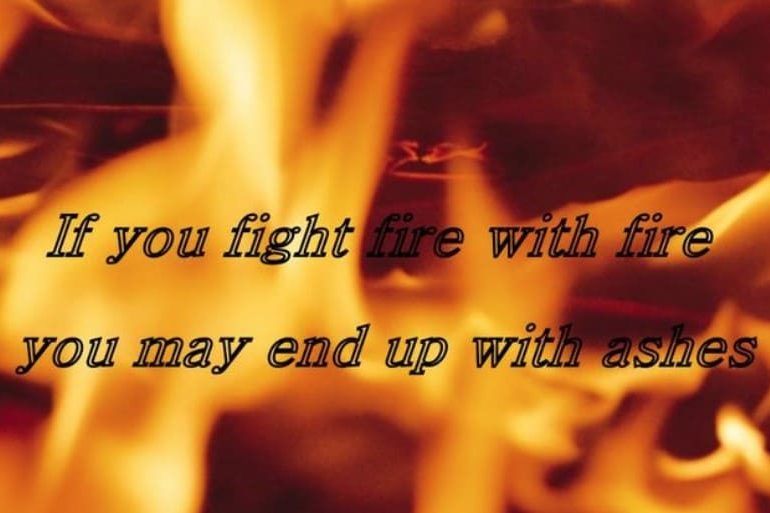“The power of fire is beneficent when man tames and guards it,” says Schiller’s “Song of the Bell”. A piece of wisdom that has stood the test of time to this day.
Mastery of Fire
Even a little carelessness in handling fire can endanger human life and cause terrible devastation.
Man did not invent fire, but discovered it as a useful tool. Thousands of years ago, it helped him to make a huge evolutionary leap.
Man learned to deal with fire and recognized its benefits: it illuminated the darkness for him, protected him from cold and animals, helped him to prepare his food edible and digestible, destroyed disease-causing waste. With the help of fire, he was able to live in regions where he would otherwise have had difficulty surviving.
Some finds indicate that our ancestors – more precisely: Homo erectus – already used the power of fire around 1.5 million years ago. But the question of when humans were able to ignite fire on their own is still being hotly debated among researchers. Many assume that the Neanderthals were able to do this with the help of flints 40,000 years ago.
What is fire and how is it created?
Three things are needed for a fire: fuel, heat and oxygen. In the heat, the fuel reacts with the oxygen in the air, oxidation occurs. This means that the molecules of the fuel combine with the oxygen and heat is released in the process. Fire is what is known as an exothermic reaction: it produces more heat than is needed to start the reaction.
In order to start a fire, you need an initial ignition or starting heat, at which the chemical combustion process of the fuel starts and continues in a kind of chain reaction. In nature, an initial spark can be, for example, lightning that strikes a tree.
The initial heat causes the flame, and the heat generated sets a chain reaction in motion: The fire now burns out of its own accord until one of the three things – fuel, heat or oxygen – is no longer there.
Erasure methods
Once a fire has started, it can quickly get out of control and reach life-threatening proportions within a few minutes. In order to put out a fire, one has to remove either the heat, the fuel or the oxygen from it. Sounds very easy.
But the extinguishing method depends on the burning materials. The best extinguishing agent is still water: it is cheap, environmentally friendly and available almost everywhere in unlimited quantities. In the case of fires, it is used either as a thick extinguishing jet or as a rain of droplets.
Spraying water on something that’s burning drains energy from the flame—so much so that there’s not enough energy left to combine with the fuel and oxygen to fuel the fire. For example, if water is sprayed onto a piece of glowing charcoal, the charcoal fuel cools down more and more.
In addition, steam is created that rises – another extinguishing effect: the steam becomes a barrier that reduces the oxygen supply. The flame gets smaller until it finally goes out. That is, water extinguishes because it’s cool, not because it’s wet.
But there are also fires that should never be extinguished with water: liquid fires, for example. Small or large explosions can occur here. Grease fires can cause jets of flame several meters high: the water droplets penetrate the hot liquid and evaporate in fractions of a second, expanding considerably in the process.
This ejects fuel particles into the air, which explode immediately upon contact with the oxygen in the air. Liquid fires are extinguished with foam. This separates the fuel from the oxygen. Extinguishing gas should be used where materials such as computers stand. A fat fire in the pan can be extinguished simply by putting a lid on the pan. This takes the air out of the fire.
Fire protection in the home
A fire in the home is quick to ignite. A burning cigarette falls to the ground, children light matches, an outdated electrical appliance causes a smoldering or cable fire. But despite the high risk of fire in the home, fire extinguishers are not always to hand. They are often missing, outdated or poorly maintained.
Existing devices should be checked by a specialist every two years, and devices that are more than 20 years old should be replaced with new ones. The fire extinguisher should be mounted in such a way that it is quickly to hand, for example in the hallway or entrance area. Pictograms printed on the bottle provide information about the fire classes for which the fire extinguisher is suitable.
Class A fires are solid materials such as wood, paper, or textiles, Class D fires are metals such as aluminum or lithium. It is important to be familiar with how to use a fire extinguisher before an emergency occurs. Only small fires can be completely extinguished with it, so timely use is important.
Fires often break out at night and the victims of the fire are surprised while they are sleeping. Those affected often become unconscious from the carbon monoxide before they wake up from the urge to cough and die not from the flames but from the effects of smoke inhalation. Smoke detectors can therefore become lifesavers.
Most of the commercially available smoke detectors work optically and emit a shrill signal tone as soon as smoke particles enter their measuring chambers. In order to be protected even in the event of a power failure, the devices should be battery-operated. There are special thermal detectors for the kitchen that react to heat instead of steam in order to avoid frequent false alarms.
About Fire…
A burnt child shuns fire. – Anyone who has had a bad experience does not want to repeat it and is particularly careful next time.
A message spreads like wildfire. – Originally, a bush fire was probably not meant here, but a military term: the gunfire of several shooters who fired a shot in quick succession, or a burning trail of black powder.
Pour oil on the fire. – In earlier times, people knew that they definitely didn’t want to do something like that. The exploding fat-water mixture can cause serious injuries.
Fire in the heart gives smoke to the head.- Too much unreflected devotion can cloud the mind.
Stoke the Fire – Drawing a poker through the fire improves oxygenation and combustion. Similarly, one can fuel a smoldering argument between people.
Don’t touch something with the tongs. – In the past, glowing charcoal was taken out of a fireplace with tongs. Anyone who doesn’t even want to touch something with such dirty pliers obviously has a great deal of reluctance.
Be on fire for something. – Probably a very old proverb with Germanic roots. “Fire and Flame” described one’s own household with a hearth. Today a metaphor for passionate love or great enthusiasm.
Being fired from the job. – Casual term for dismissals, especially for dishonorable terminations.
Burning your fingers. Everyone knows that and how painful it is. Both the symbolic damage and the real injury.
Giving Tinder to Someone – Tinder is actually a highly combustible tree fungus that has been used to make fire, believed to have been used for thousands of years.
This is a straw fire. – The straw catches fire very quickly and burns brightly. But the dry fuel is quickly used up. So it is with hectic and insubstantial activities that end abruptly when the energy is exhausted.
Fire starts with sparks. Even a fire starts small and can become huge, intentionally or unintentionally.
Having several irons in the fire. – The origin of this expression is probably the traditional way a blacksmith works. A blacksmith has several red-hot workpieces in the fire at the same time in order to be able to process them quickly.
Light a fire under someone’s buttocks. – Whoever has it burning under their buttocks will finally hurry up.
Playing with fire. – Of course, you should never take such a risk…
To put one’s hand in the fire for someone. The Dark Ages were the inspiration for this saying: anyone who wanted to prove their innocence could sometimes put their hand in the fire as a “divine judgment”. The more severely she was burned, the greater the guilt supposedly.
Crooked wood also makes straight fire.– Top quality is not required for some profane purposes.
Get the chestnuts (or potatoes) out of the fire. The proverb has a literary basis: in the story “The Monkey and the Cat” by Jean de la Fontaine, the monkey Bertrand persuades the cat Raton to eat delicious chestnuts out of a fire steal.
Get the irons out of the fire.– Perhaps wrought iron is meant here. They may not be as tasty as chestnuts or potatoes, but they are incandescent at around 1200 degrees.
To walk through fire for someone. Sometimes you have to risk a lot – for a person or for an important ideal.
There is no smoke without fire. This is where the assumption is hidden that there is always a grain of truth behind rumors and suspicions. If that’s true…





